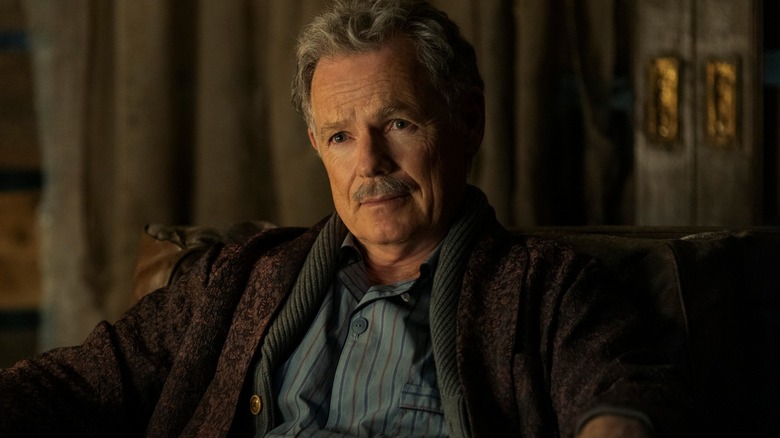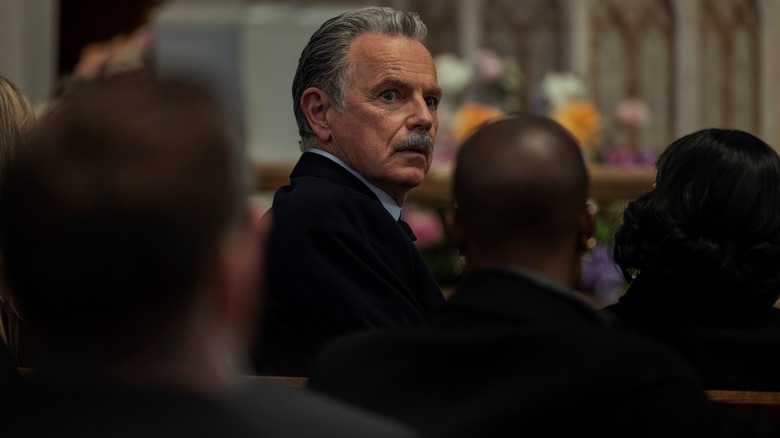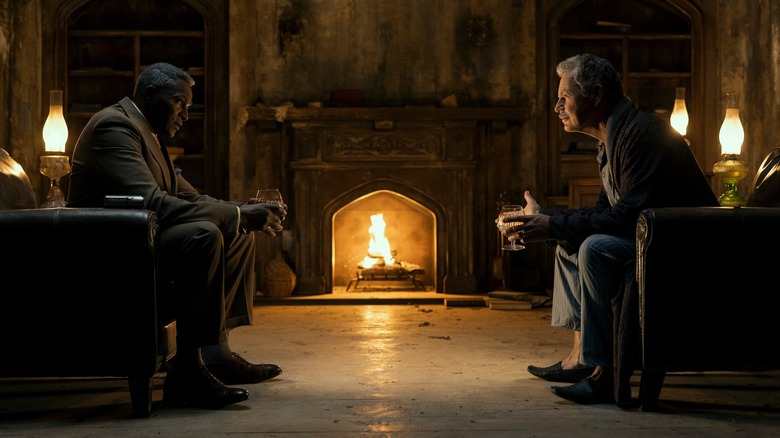The Fall Of The House Of Usher: What Do The Bells & The Jester Really Mean?
Contains spoilers for "The Fall of the House of Usher"
Edgar Allan Poe's "Hop-Frog" has an episode named after it on Netflix's "The Fall of the House of Usher." However, viewers shouldn't go into Mike Flanagan's latest memorable project expecting an adaptation of the short story. The original tale tells the story of Hop-Frog, an enslaved jester for an abusive king who decides to get payback by putting on a masquerade the court and its guests will never forget. But how does it factor into the Netflix show?
With only eight episodes to tell its story, "The Fall of the House of Usher" can't adapt all of Poe's horror yarns. Tales such as "Masque of the Red Death" and "The Black Cat" get entire episodes dedicated to them; however, some of the author's lesser-known works have ideas, names, and references weaved into the proceedings. This is the case for "Hop-Frog," which is represented through the visual imagery of a jester who haunts Roderick Usher (Bruce Greenwood) throughout the season. The patriarch also hears bells in some episodes, which is a nod to Poe's "The Bells" poem. With that in mind, let's examine how these stories inform Flanagan's horror series.
The significance of the bells and the jester
"The Fall of the House of Usher" features a couple of nods to "The Bells" and "Hop-Frog." In the former, bells are used to signify the four specific periods of one's life: childhood, youth, maturity, and death. Mike Flanagan's series uses bells to accompany Roderick Usher's mother's death in Episode 1, "A Midnight Dreary," and they proceed to soundtrack notable stages of the ruthless pharmaceutical titan's own sordid life journey.
"Hop-Frog," meanwhile, sees the titular jester concoct a plan to humiliate and destroy a tyrannical king and his cabinet. He convinces the royal figures to dress up as orangutans and chain themselves together as a way to scare the court guests; naturally, the royals love this idea as inflicting cruelty and scaremongering on commoners amuses them. Afterward, Hop-Frog torches his chained oppressors until they burn to a crisp. Ultimately, "Hop-Frog" positions its titular jester as a symbol of death and revenge, and this idea is carried over into Flanagan's "Fall of the House of Usher" series.
The Fall of the House of Usher embraces Hop-Frog's themes
Edgar Allan Poe's "Hop-Frog" is a story about oppression that examines the theme of inequality. The king and his cabinet treat the titular character and his friend Trippetta as their playthings, mocking and abusing them at will for their own amusement. It's one of several Poe stories that critique gluttonous wealth and corrupt institutions, and some of its themes are proving to be timeless. Mike Flanagan understands this, as he brings the author's worldview to "The Fall of the House of Usher" while applying it to the horrors of modern times.
Roderick Usher is the corrupt king figure in "The Fall of the House of Usher," and his family is his cabinet of bullies, abusers, manipulators, and liars. Whether they're using regular people as guinea pigs in experimental medical trials or killing their own lovers to stop them from squealing about the family's corruption, the Ushers epitomize rich people doing bad things to other people for their own gain. Roderick is the lynchpin behind all of the corruption, so he must be overthrown to end the vicious cycle. Similar to the royal court in Poe's "Hop-Frog" story, "The Fall of the House of Usher" is about an empire falling, and it makes sense to use the symbolism of the bells and the jester to chronicle its leader's downfall.


